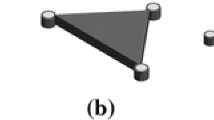Abstract
Based on the edge-based array representation of loops in the topological graphs of kinematic chains, this paper first proposes three arithmetic operations of loops. Then the concept of the independent loop set as well as its determination rules is introduced, and a new structure decomposition algorithm of kinematic chains is presented. Based on the algorithm, an automatic and efficient method for rigid sub-chain detection and driving pair selection of kinematic chains is proposed. Finally, an index is proposed to assess computation complexity of kinematic analysis with respect to different driving pair selections.








Similar content being viewed by others
References
Yang TL (1995) Basic theory of mechanical system—structical kinematics dynamics (in Chinese). Mechanical Press, Beijing, pp 1–69
Mruthyunjaya TS (2003) Kinematic structure of mechanisms revisited. Mech Mach Theory 38(4):279–320
Uicker JJ, Raicu A (1975) A method for the identification of and recognition of equivalence of kinematic chains. Mech Mach Theory 10(5):375–383
Liu XJ, Wang JS, Pritschow G (2005) A new family of spatial 3-DoF fully-parallel manipulators with high rotational capability. Mech Mach Theory 40:475–494
Chu JK, Cao WQ (1998) Systemic of Assur groups with multiple joints. Mech Mach Theory 33(8):1127–1133
Crossley FRE (1965) The permutations of kinematic chains of eight members or less from the graph theoretic point of view. Dev Theor Appl Mech 2:467–486
Freudenstein F, Dobrjanskyj L (1964) In: Proceedings of the 11th international congress applications of mechanics. Springer, pp 420–428
Woo LS (1967) Type synthesis of plane linkages. Trans ASME J Eng Ind 89B:159–172
Hung CC, Yan HS, Pennock GR (2008) A procedure to count the number of planar mechanisms subject to design constraints from kinematic chains. Mech Mach Theory 43(6):676–694
Yan HS, Hwang YW (1990) Number synthesis of kinematic chains based on permutation groups. Math Comput Model 13(1):29–42
Sunkari RP, Schmidt LC (2006) Structural synthesis of planar kinematic chains by adapting a Mckay-type algorithm. Mech Mach Theory 41(9):1021–1030
Tischler CR, Samuel AE, Hunt KH (1995) Kinematic chains for robot hands. I: orderly number synthesis. Mech Mach Theory 30(8):1193–1215
Mruthyunjaya TS, Balasubramanzan HR (1987) In quest of a reliable and efficient computational test for detection of isomorphism in kinematic chains. Mech Mach Theory 22(2):131–140
He PR, Zhang WJ, Li Q et al (2003) A new method for detection of graph isomorphism based on the quadratic form. ASME J Mech Des 125(3):640–642
Sunkari RP, Schmidt LC (2006) Reliability and efficiency of the existing spectral methods for isomorphism detection. ASME J Mech Des 128(6):1246–1252
Ding HF, Huang Z (2007) The establishment of the canonical perimeter topological graph of kinematic chains and isomorphism identification. ASME J Mech Des 129(9):915–923
Hwang W, Hwang Y (1992) Computer aided structure synthesis of planar kinematic chains with simple joints. Mech Mach Theory 27(2):189–199
Hwang W, Hwang Y (1991) An algorithm for the detection of degenerate kinematic chains. Math Comput Model 15(11):9–15
Tuttle ER (1996) Generation of planar kinematic chains. Mech Mach Theory 31(6):729–748
Lee H, Yoon Y (1992) Detection of rigid structure in enumerating basic kinematic chain by sequential removal of binary link string. JSME Int J 35(4):647–651
Lee H, Yoon Y (1996) Algorithm to identify the types of degrees of freedom in kinematic chains. JSME Int J 39(1):144–148
Crossley FRE (1964) A contribution to Gruebler’s theory in the number synthesis of planar mechanisms. J Eng Indust, ASME Trans Series B 86:1–8
Manolescu NI (1964) A unitary method for construction of the kinematic plane chains and plane mechanisms with different degrees of mobility. Revue Roumaine des Sciences Techniques, Serie de Mecanique Appliquee 9:1263–1313
Acknowledgments
This research is sponsored by the NSFC (Grant No. 50905155), the China Postdoctoral Science Foundation Funded Project (Grant No. 200801271 and No. 20080430122), and the Hebei Nature Science Foundation under Grant E2008000808.
Author information
Authors and Affiliations
Corresponding author
Rights and permissions
About this article
Cite this article
Ding, H., Zhao, J. & Huang, Z. The establishment of edge-based loop algebra theory of kinematic chains and its applications. Engineering with Computers 26, 119–127 (2010). https://doi.org/10.1007/s00366-009-0141-6
Received:
Accepted:
Published:
Issue Date:
DOI: https://doi.org/10.1007/s00366-009-0141-6




